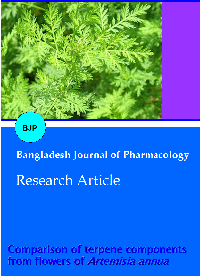Comparison of terpene components from flowers of Artemisia annua
DOI:
https://doi.org/10.3329/bjp.v7i2.10815Keywords:
Artemisia annua, Essential oil, Flowering, Monoterpene, SesquiterpeneAbstract
Terpene constituents of essential oils obtained by steam distillation from Artemisia annua flowers at the pre-, full- and post-flowering stage was investigated by gas chromatography (GC) and gas chromatography-mass spectrometric detector (GC-MS). The aim was to evaluate change the biosynthesis pathway of terpenes at different flowering stages. The samples studied showed that main components of essential oils were monoterpenes hydrocarbons (48.1%) and oxygenated monoterpenes (41%) in the pre-flowering, oxygenated monoterpenes (35.6%) and sesquiterpenes hydrocarbons (5.0%) in the full-flowering, and oxygenated monoterpenes (29.6%), sesquiterpenes hydrocarbons (32.2%) and oxygenated sesquiterpenes (25.3%) in the post-flowering, respectively. The relative content of monoterpenes decreased from pre-flowering to post-flowering, while that of sesquiterpenes increased. The results indicated that the biosynthesis pathway of terpenes might be changed at different flowering at stages, while the change of content and composition of terpenes might be a self-adaptation of A. annua.
Downloads
393
582 Read
78
References
Bertea CM, Freije JR, Van DWH, Verstappen FW, Perk L, Marquez V, De Kraker JW, Posthumus MA, Jansen BJ, de Groot A, Franssen MC, Bouwmeester HJ. Identification of intermediates and enzymes involved in the early steps of artemisinin biosynthesis in Artemisia annua. Planta Med. 2005; 71: 40-47.
Brown GD, Liang GY, Sy LK. Terpenoids from the seeds of Artemisia annua L. Phytochemistry 2003; 64: 303-23.
Dudai N, Putievsky E, Ravid U, Palevitch D, Halevy AH. Monoterpene content in Origanum syriacum as effected by environmental conditions and flowering. Phys Plant. 1992; 84: 45359.
Goel D, Singh V, Ali M, Mallavarupu GR, Kumar S. Essential oils of petal, leaf and stem of the antimalarial plant Artemisia annua. J Nat Med. 2007a; 61: 187-91.
Goel D, Singh V, Ali M, Mallavarupu GR, Kumar S Composition of the essential oil from the root of Artemisia annua. J Nat Med. 2007b; 61: 458-61.
Haider F, Dwivedi P, S Singh, Naqvi AA, Bagchi G. Influence of transplanting time on essential oil yield and composition in Artemisia annua plants growth under the climatic conditions of sub-tropical north India. Flavour Fragrance J. 2004; 19: 51-53.
Hashemi P, Abolghasemi MM, Fakhari AR, Ebrahimi SN, Ahmadi S Hydrodistillationsolvent microextraction and GCMS identification of volatile components of Artemisia aucheri. Chromatographia 2007; 66: 283-86.
Iraj Ri, Rezaee MB, Moosavi ML, Kamkar J. Microbial sensitivity to and chemical properties of the essential oil of Artemisia annua L. J Essent Oil Res. 2003; 15: 59-62.
Jain N, Srivastava SK, Aggarwal KK, Kumar S, Syamasundar KV, Jain N, Kumar S. Essential oil composition of Artemisia annua L. 'Asha' from the plains of Northern India. J Essent Oil Res. 2002; 14: 305-07.
Juteau F, Masotti V, Bessière JM, Dherbomez M, Viano J Antibacterial and antioxidant activities of Artemisia annua essential oil. Fitoterapia 2002; 73: 532-35.
Klayman DL. Qinghaosu (Artemisinin): An antimalarial drug from China. Science 1985; 228: 1049-55.
Liu Q, Yang ZY, Deng ZB, Sa GH, Wang XJ. Preliminary analysis on chemical constituents of essential oil from inflorescence of A. annua L. Acta Botanica Sinica 1988; 30: 223-25.
Ma CF, Wang HH, Lu X, Li HF, Liu B, Xu GW. Analysis of Artemisia annua L. volatile oil by comprehensive two-dimensional gas chromatography time-of-flight mass spectrometry. J Chromatogr. A 2007; 1150: 5053.
Perazzo FF, Carvalho JCT, Carvalho JE, Rehder VLG. Central properties of the essential oil and the crude ethanol extract from aerial parts of Artemisia annua L. Pharmacol Res. 2003; 48: 497-502.
Soylu EM, Yigitbas H, Tok FM, Soylu S, Kurt S, Baysal Ö, Kaya AD. Chemical composition and antifungal activity of the essential oil of Artemisia annua L. against foliar and soil-borne fungal pathogens, Zeitschrift für Pflanzenkrankheiten und Pflanzenschutz 2005; 112: 229-39.

Published
How to Cite
Issue
Section
License
Authors who publish with this journal agree to the following terms:
- Authors retain copyright and grant the journal right of first publication with the work simultaneously licensed under a Creative Commons Attribution License that allows others to share the work with an acknowledgement of the work's authorship and initial publication in this journal.
- Authors are able to enter into separate, additional contractual arrangements for the non-exclusive distribution of the journal's published version of the work (e.g., post it to an institutional repository or publish it in a book), with an acknowledgement of its initial publication in this journal.
- Authors are permitted and encouraged to post their work online (e.g., in institutional repositories or on their website) prior to and during the submission process, as it can lead to productive exchanges, as well as earlier and greater citation of published work (See The Effect of Open Access).
